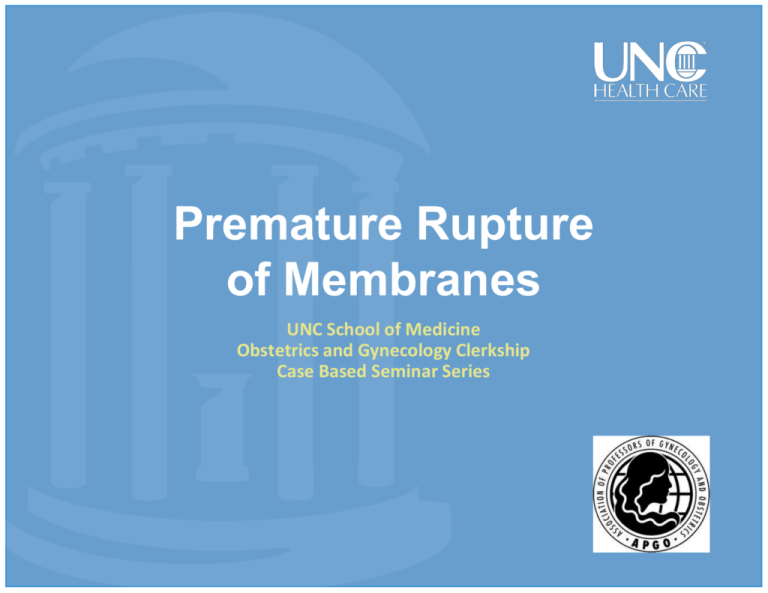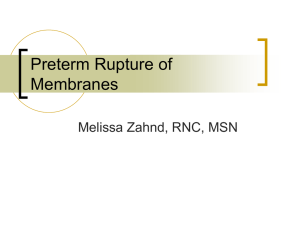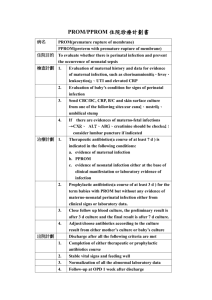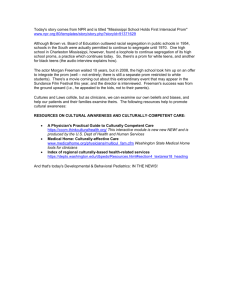PROM 7-11-11 - UNC School of Medicine
advertisement

Premature Rupture of Membranes UNC School of Medicine Obstetrics and Gynecology Clerkship Case Based Seminar Series Objectives for PROM List the history, physical findings, and diagnostic methods to confirm the rupture of the membranes Identify the risk factors for premature rupture of membranes Describe the risks and benefits of expectant management versus immediate delivery, based on gestational age Describe the methods to monitor maternal and fetal status during expectant management Definition Premature rupture of membranes (PROM) Rupture of the chorioamnionic membrane (amniorrhexis) prior to the onset of labor at any stage of gestation Preterm premature rupture of membranes (PPROM) PROM prior to 37-wk. gestation Incidence PROM – 12% of all pregnancies PROM – 8% term pregnancies PPROM – 30% of preterm deliveries PROM/PPROM: History & Physical Exam History “Gush” of fluid Steady leakage of small amounts of fluid Physical Sterile vaginal speculum exam Minimize digital examination of cervix, regardless of gestational age, to avoid risk of ascending infection/amnionitis Assess cervical dilation and length Obtain cervical cultures (Gonorrhea, Chlamydia) Obtain amniotic fluid samples Findings Pooling of amniotic fluid in posterior vaginal fornix Fluid per cervical os PROM/PPROM: Diagnosis Test Nitrazine test Fluid from vaginal exam placed on strip of nitrazine paper Paper turns blue in presence of alkaline (pH > 7.1) amniotic fluid Fern test Fluid from vaginal exam placed on slide and allowed to dry Amniotic fluid narrow fern vs. cervical mucus broad fern PROM/PPROM: Diagnosis False positive Nitrazine test Alkaline urine Semen (recent coitus) Cervical mucus Blood contamination Vaginitis (e.g. Trichomonas) False-Negative Nitrazine test Remote PROM with no residual fluid Minimal amniotic leakage PROM/PPROM: Diagnosis Test Ultrasound Assess amniotic fluid level and compatibility with PROM Indigo-carmine Amnioinfusion Ultrasound guided indigo carmine dye amnioinfusion (“Blue tap”) Observe for passage of blue fluid from vagina PROM/PPROM: Risk Factors Risk Factors: Prior PROM or PPROM Prior preterm delivery Multiple gestation Polyhydramnios Incompetent cervix Vaginal/Cervical Infection Gonorrhea, Chlamydia, GBS, S. Aureus Antepartum bleeding (threatened abortion) Smoking Poor nutrition Management: PPROM (< 24 wk gestation – “previable”) Patient counseling Expectant management vs. induction of labor GBS prophylaxis NOT recommended Antibiotics Incomplete data Corticosteriods NOT recommended Management: PPROM (< 24 wk gestation – “previable”) Patient counseling Outcomes at 18 to 22 Months Corrected Age* Gestational Age (In Completed Weeks) Death Before NICU Discharge 22 Weeks 23 Weeks 24 Weeks 25 Weeks 95% 74% 44% 24% Death Death/ Profound Neurodevelopmental Impairment Death/Moderate to Severe Neurodevelopmental Impairment 95% 74% 44% 25% 98% 84% 57% 38% 99% 91% 72% 54% Fetal complications of prolonged PPROM Pulmonary hypoplasia Skeletal malformations Fetal growth restriction IUFD Maternal complications of prolonged PPROM Chorioamnionitis http://www.nichd.nih.gov/about/org/cdbpm/pp/prog_epbo/dataShow.cfm Management: PPROM (24 – 31 wk gestation) Expectant management Deliver at 34 wks Unless documented fetal lung maturity GBS prophylaxis Antibiotics Single course corticosteroids Tocolytics No consensus Management: PPROM (32 – 33 wk gestation) Expectant management Deliver at 34 wks Unless documented fetal lung maturity GBS prophylaxis Antibiotics Corticosteroids No consensus, some experts recommend Management: PROM (> 34 wk gestation) Proceed to delivery Induction of labor GBS prophylaxis Management: Rationale Antibiotics Prolong latency period Prophylaxis of GBS in neonate Prevention of maternal chorioamnionitis and neonatal sepsis Corticosteroids Enhance fetal lung maturity Decrease risk of RDS, IVH, and necrotizing enterocolitis Tocolytics Delay delivery to allow administration of corticosteroids Controversial, randomized trials have shown no pregnancy prolongation Management: Drug Regimen Antibiotics Ampicillin 2 g IV Q6 x 48 hrs Amoxicillin 500 mg po TID x 5 days Azithromycin 1 g po x 1 Corticosteroids Betamethasone 12 mg IM q24 x 2 Dexamethasone 6 mg IM q12 x 4 Tocolytics Nifedipine 10 mg po q20min x 3, then q6 x 48 hrs Management: Amniocentesis Typically performed after 32 wks Tests for fetal lung maturity (FLM) Lecethin/Sphingomyelin ratio (not commonly used, more for historic interest) L/S ratio > 2 indicates pulmonary maturity Phosphatidylglycerol > 0.5 associated with minimal respiratory distress Flouresecence polarization (FLM-TDx II) > 55 mg/g of albumin Lamellar body count 30,000-40,000 If negative, proceed with expectant management until 34 wks Courtesy of Thomas Shipp, MD. Management: Surveillance Maternal: Monitor for signs of infection Temperature Maternal heart rate Fetal heart rate Uterine tenderness Contractions Fetal: Monitor for fetal well-being Kick counts Nonstress tests (NST’s) Biophysical profile (BPP) Management: Surveillance Immediate Delivery Intrauterine infection Abruptio placenta Repetitive fetal heart rate decelerations Cord prolapse Expectant Management vs. Preterm Delivery Expectant Management Risks: Maternal Increase in chorioamnionitis Increase in Cesarean delivery Spontaneous labor in ~ 90% within 48 hr ROM Increased risk of placental abruption Fetal Increase in RDS Increase in intraventricular hemorrhage Increase in neonatal sepsis and subsequent cerebral palsy Increase in perinatal mortality Increase in cord prolapse Expectant Management vs. Preterm Delivery Preterm Delivery Risks: use NICHD calculator http://www.nichd.nih.gov/about/org/cdbpm/pp/prog_ep bo/epbo_case.cfm Gestation (w) Weight Sex Steroids Survival Survival w/o profound ND impairment 25 550 Female Yes 64% 50% 24 500 Male Yes 35% 22% 23 450 Male Yes 16% 9% 22 401g Female No 2% 1% Bottom Line Concepts Preterm premature rupture of membranes refers to rupture of fetal membranes prior to labor in pregnancies < 37 weeks. A history of PPROM or PROM, genital tract infection, antepartum bleeding, and smoking are risk factors for PPROM and PROM. A clinical history suggestive of PPROM or PROM should be confirmed with visual inspection and laboratory tests including ferning and nitrazine paper. Management of PPROM at < 24 wks includes a discussion with the family reviewing the maternal risks against the fetal risks of significant morbidity and mortality during expectant management. For women with PPROM or PROM in whom intrauterine infection, abruptio placenta, repetitive fetal heart rate decelerations, or a high risk of cord prolapse is present, immediate delivery is recommended. Counseling after the delivery for the recurrence risk of PROM should occur, and modifiable risk factors addressed References and Resources APGO Medical Student Educational Objectives, 9th edition, (2009), Educational Topic 25 (p52-53). Beckman & Ling: Obstetrics and Gynecology, 6th edition, (2010), Charles RB Beckmann, Frank W Ling, Barabara M Barzansky, William NP Herbert, Douglas W Laube, Roger P Smith. Chapter 22 (p213-217). Hacker & Moore: Hacker and Moore's Essentials of Obstetrics and Gynecology, 5th edition (2009), Neville F Hacker, Joseph C Gambone, Calvin J Hobel. Chapter 12 (p150-153).








